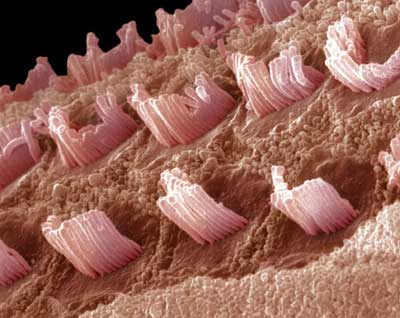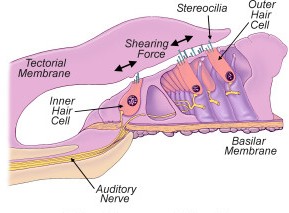July 16, 2015 – Scientists at Ecole Polytechnique Federale de Lausanne and their compatriots at Boston Children’s Hospital have reported successful gene manipulation impacting the hair cells of the inner ear to restore hearing in mice. Their findings appeared in the July 8th issue of the journal, Science Translational Medicine.
The researchers describe their efforts in an article entitled, Tmc gene therapy restores auditory function in deaf mice. The focus was on micro-deletions in two genes responsible for dominant deafness. By using a modified virus as a delivery mechanism, they were able to implant augmented genetic information responsible for normal inner ear hair cell growth and function through an injection.
There are two types of hair cells in the ear – inner and outer. The cells have stereocilia, the hairs you see sticking out in the image above. Beneath the hairs are the cells attached to the ear’s basilar membrane while the hairs contact the tectorial membrane. Sound waves cause the basilar membrane to vibrate which makes the hairs wave side to side where their contact with the tectorial membrane creates electric signals transmitted by the auditory nerve to the brain. If the hairs do not grow properly because of a defective gene, no sound is heard. The diagram below gives you a good anatomical rendering of the position and interaction of these essential auditory parts.
Why is the use of genetic modification for hearing loss so important? Because 50% of deafness observed in humans has genetic origins. And with hearing loss impacting 360 million on the planet, approximately 5% of the world’s population, being able to correct the problem through gene therapy for 180 million sounds like a pretty good investment.
The researchers into neo-natal deafness ascribe it to defects in 70 individual genes. In this study two are targeted representing only a subset of all genetically caused forms of deafness.
When researchers were asked how they knew their patients could hear, they said all we did was turn on some noise and watch how high the baby mice jumped.












